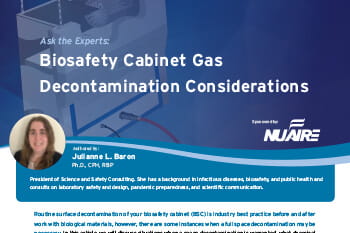
Article
Biosafety Cabinet Gas Decontamination Considerations
In "Biosafety Cabinet Gas Decontamination Considerations," authored by Julianne L. Baron, Ph.D., CPH, RBP, the article emphasizes the importance of routine surface decontamination in biosafety cabinets (BSCs) for maintaining a sterile work environment. However, it also outlines scenarios where full space decontamination, or gas decontamination, becomes necessary.
The article identifies situations warranting gas decontamination, such as before HEPA filter changes, maintenance, relocation of the BSC, significant spills, or when working in high biosafety level (BSL) laboratories. It discusses three common chemical sterilants for BSC gas decontamination - formaldehyde, chlorine dioxide, and hydrogen peroxide - noting their EPA registration, use cases, safety, penetration capabilities, cycle times, material compatibility, and residual effects.
The gas decontamination process includes preparation steps, isolation of the BSC from building exhaust, sealing, and considerations for surrounding areas. The article underscores the importance of using qualified personnel for decontamination equipped with monitoring equipment and personal protective gear. It highlights that these chemical agents, while effective against biological materials, pose risks to human health, with formaldehyde being a known carcinogen.
The article also advises selecting a qualified gas decontamination provider, suggesting consulting NSF's list of accredited biosafety cabinet field certifiers and the BSC manufacturer for recommendations.
Design features of BSCs that facilitate gas decontamination are explored, emphasizing the importance of front access, exhaust openings that can be sealed, and features that allow for the effective circulation of the sterilant.
In conclusion, the article asserts the necessity of understanding the process and design features of BSCs to effectively prepare for and select a qualified BSC gas decontamination provider, especially given the infrequency but critical nature of this service.

